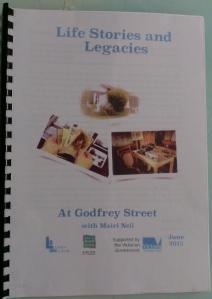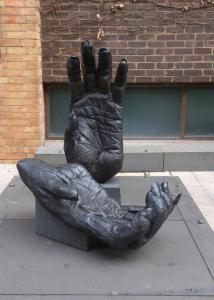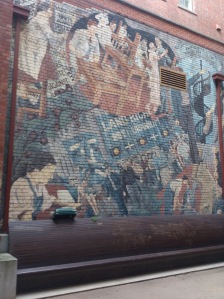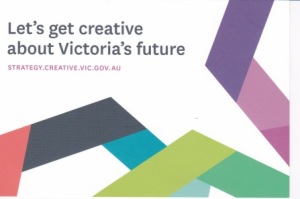“The arts are not a way to make a living. They are a very human way of making life more bearable. Practicing an art, no matter how well or badly, is a way to make your soul grow, for heaven’s sake. Sing in the shower. Dance to the radio. Tell stories. Write a poem to a friend, even a lousy poem. Do it as well as you possibly can. You will get an enormous reward. You will have created something.”
This quote is appealing, but why shouldn’t creative people be entitled to ‘make a living’? One of my dreams, and I know I’m not alone, would be supporting myself from my writing, I’ve never had that luxury. I teach in several different places each week and always chase money to pay the bills. I’m fortunate to teach creative writing and be in the company of those who value words, but to be able to spend unrestricted hours writing what I want is an unfulfilled desire.

On Friday, I attended a consultation session at the Melbourne Town Hall convened by the new Victorian Government to consult with those in the creative sector to contribute towards developing “a creative industries strategy that increases the benefits that flow to the State from a vibrant creative and cultural sector.
The strategy will take a whole-of-state approach to enabling the creative and cultural industries to thrive and make a major contribution to Victoria’s future as a liveable, inclusive, prosperous and vibrant society.”
Those present at one of the many consultations that will be held were invited to contribute views, ideas and aspirations in a spirit of innovation and collaboration with the facilitator adamant Martin Foley, Victoria’s Minister for Creative Industries is open to new ideas and new approaches and wanted feedback on ten themes:
Fostering creative excellence
Building audiences and markets
Enhancing creative spaces and places
Cultivating skills, entrepreneurship and innovation
Harnessing the opportunities of digital technology
Increasing participation and social impact
Supporting Aboriginal arts and culture
Advancing regional Victoria and outer metropolitan Melbourne
Enhancing international engagement
Increasing tourism
In the discussion paper it was noted:
“The creative and cultural industries are a broad but interconnected field spanning arts, culture, screen and design. They encompass disciplines as diverse as game development and graphic design, fashion and filmmaking, performing arts and publishing, architecture and advertising, media and music, comedy and craft. They include activities that are commercially-driven and community- based, experimental and export ready.”
In the room, a dozen large round tables accommodated ten – twelve people. Each of us had a piece of butcher paper and coloured Textas and a scribe with a whiteboard sat out the front to collate.
Halfway through the morning some people swapped tables to ensure the maximum mix in discussion time. My table had a theatre director, a theatre/gallery owner, a university lecturer, a costume designer, a freelance HR manager in the arts industry, Federation Square’s arts project manager and her assistant, an arts council representative for City of Yarra, and an arts and sports event/festival organiser for the City of Bass, a youth music organiser, and an independent artist.
All of us agreed that our greatest challenge was having a decent income to support our art; to allow us the breathing space and time to start and finish projects. We lamented the churning out of graduates in the creative industries who can’t get jobs in their field, haven’t the workshop or studio space, and can’t afford the equipment or technology to pursue their artistic endeavours.
The devaluing of art or creativity starts in schools when there is no designated art teacher. It is carried through to art subjects being marked down at VCE and even in government when Martin Foley is the Victorian Minister for Equality. He is also the Minister for Housing, Disability Services & Ageing, Minister for Mental Health and Minister for Creative Industries. (Mr Foley previously served as the Shadow Minister for Water, Shadow Minister for Arts and Shadow Minister for Youth Affairs.) How important is ‘the arts’ if the minister has to multitask between a variety of sectors?
Everyone desired a model for economic security – the time spent chasing, securing and retaining funding a problem, especially if bureaucrats have a concept that creativity can be switched on and off and run to a timetable.
Perhaps we need to look at funding in other sector models like those used by charities and social services, but most of all the Minister for the Arts/Creative Industries needs to speak to the Minister for Education!
The TAFE system is hands, Universities the head – lots of crossover in creative industries, so both systems need to be funded adequately.


There needs to be more collaboration between government sectors and artists: the three tiers of government (local council, state and federal governments) make finding and funding resources a nightmare. The lack of affordable space to develop and present new work, whether it is sculpture or performing arts, can be an almost insurmountable challenge for artists who need to meet and engage with an audience.
The discussion and debate made the air thrum and hum with diverse voices, intense exchanges, shared laughter and plenty of storytelling. Archaeologist, historian, writer or industrial designer – all have a story and ideas to share – although some people took the view of a narrow definition of ‘professional’ artist.
Indeed what is art – a definition could be debated all day! Even referring to creative industries upset some people. How do you identify as a creative person? What label do you wear?
The sustainability of the creative sector recognised as important – presenting a challenge and opportunities. Participants agreed there was a need and often demonstration of entrepreneurial skills, but many in the sector lack business and marketing skills.
The survival and success of independent artists can be a role model for the wider community, however, we need the arts to be considered across all government portfolios like environmental impact is now considered. All government departments need to embrace funding the arts.
Embed creativity in lifestyle just as coffee is embedded.
This comment reminded me of a cafe near Brighton Beach Station where the work of a NZ poet is chalked on the eaves outside the shop!
Artistic hubs should be encouraged in outer suburbs and regional areas and when infrastructure is considered for new housing estates an arts hub could be included in the design. Art and culture should be part of building a community. Hubs would facilitate this connection. If space can be allocated for parks and gardens why not the arts?
How do you measure the value of art and culture?
“Writing isn’t about making money, getting famous, getting dates, getting laid, or making friends. In the end, it’s about enriching the lives of those who will read your work, and enriching your own life, as well. It’s about getting up, getting well, and getting over. Getting happy, okay? Getting happy.”
Stephen King
We must stop using the language of economics and business-speak – we have our own language in the arts. Why does there always have to be a dollar value? Is it true if you want to be an artist in the afternoon you must be a business person in the morning?
Isn’t investment in equity, diversity, people, and the community’s wellbeing enough? Celebrating diversity and instilling confidence in the creative community important for society’s progress. As is valuing history and heritage. Victoria must be seen to promote cultural literacy and education – sector funding needs to be appropriate as well as directing support to individual artists.
There should be investment in regular programs that work, but also risk taking to encourage innovative projects. If recurrent funding the programs must be accountable and prove their worth. More cross generational programs and culturally diverse ones are needed for balance.
Should culture be free ?
A gasp went around the room when someone asked: If people pay for attending the Grand Prix, why should White Night be free?
Put a bunch of creative people in a room and you stir up a hornet’s nest!
“The creative and cultural industries are central to our identity, to the liveability of our communities, to our social cohesion and to our productivity. They are an essential part of what differentiates Victoria from other places, and have a role to play across virtually every area of society – from education and health, to justice, science, innovation, business and community development.”
The creative and cultural industries contribute to the cultural, social and economic fabric of societies.
- What can we do to embed creativity in our everyday lives?
- What can we do to ensure the next generation will be both consumers of, and practitioners in, the creative industries?
Check out the government’s discussion paper and please have your say. It invites your contribution to the development of Victoria’s first creative industries strategy. You may choose to respond directly to the issues and themes canvassed. Or you may choose to make a general submission that addresses other issues.
Responses close on Friday 17 July 2015
“Why am I compelled to write? . . . Because the world I create in the writing compensates for what the real world does not give me. By writing I put order in the world, give it a handle so I can grasp it…”
Gloria E. Anzaldúa
Have you an opinion or ideas for the future of creativity in Victoria? Please spare a few minutes to let the government know.

